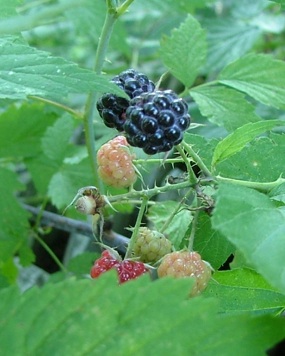
Features
Fruit
Production
Antioxidants in black raspberries influenced by production site
March 16, 2009 By American Society for Horticultural Science
 March 11, 2009, Wooster, OH — Black raspberries have been studied for
March 11, 2009, Wooster, OH — Black raspberries have been studied for
decades by scientists and medical researchers interested in the fruits’
apparent ability to limit the onset or severity of degenerative
diseases, including cancer.
March 11, 2009, Wooster, OH — Black raspberries have been studied for decades by scientists and medical researchers interested in the fruits’ apparent ability to limit the onset or severity of degenerative diseases, including cancer.
 The fruit of many popular berries, including blackberries, blueberries, strawberries, elderberries, grapes, and plums, are known to have strong antioxidant capacity, mainly as a result of high levels of anthocyanins — chemicals that give plants their vibrant colors — and other phenolic compounds. The darker the fruit, the more anthocyanins are present. Anthocyanins appear to work by inhibiting compounds that weaken the immune system and stimulate tissue inflammation. They can also destroy harmful free-radical molecules that attack cells and cause aging, heart disease, and cancer.
The fruit of many popular berries, including blackberries, blueberries, strawberries, elderberries, grapes, and plums, are known to have strong antioxidant capacity, mainly as a result of high levels of anthocyanins — chemicals that give plants their vibrant colors — and other phenolic compounds. The darker the fruit, the more anthocyanins are present. Anthocyanins appear to work by inhibiting compounds that weaken the immune system and stimulate tissue inflammation. They can also destroy harmful free-radical molecules that attack cells and cause aging, heart disease, and cancer.
The prospective health benefits of black raspberries and other antioxidant-rich produce has led to increased consumer awareness and demand for fresh, locally produced fruit.
A research study presented in the journal HortScience was designed to determine whether where black raspberries are grown influences the antioxidant level in the berries. The research group, headed by Mustafa Ozgen from the Department of Horticulture at Gaziosmanpasa University, Tokat, Turkey, included Faith J. Wyzgoski, Ohio State University at Mansfield; Artemio Z. Tulio, Jr., Aparna Gazula, A. Raymond Miller, and Joseph C. Scheerens from the Ohio Agricultural Research and Development Center; R. Neil Reese from South Dakota State University, and Shawn R. Wright of Ohio State University South Centers.
To estimate variability in phytonutritional quality of black raspberries, the researchers studied 19 samples representing four common black raspberry cultivars harvested from eight different production sites. Samples were frozen within 24 hours of harvest in on-farm, conventional freezers. These materials were transported in their frozen state to the Ohio Agricultural Research and Development Center and stored in 100 g batches at 29 °C until analyzed. The team then evaluated each of the cultivars to determine antioxidant levels.
“Inverse relationships among black raspberry samples suggested that site differences may be partially attributable to fruit ripeness at harvest,” said the researchers. “Relationships among these parameters versus regional differences in soil temperatures were also significant, but weak.”
Variation in fruit phytonutrient contents related to growing location may prove important in future health-related studies or clinical applications, as well as affecting nutritional benefits to consumers.
The study also contains recommendations for black raspberry growers and marketers, indicating that phytonutrient levels may be affected by genetic, cultural, and/or environmental factors.
“Black raspberry producers wishing to optimize antioxidant levels of their fruit products must consider how greatly antioxidant levels might vary among locally grown cultivars from harvest site to harvest site and, as a consequence, of how they are handled and marketed.” remarked Ozgen.
Based on this preliminary research, the team continues to explore the effects of culture, ripening, posthavest practices, heat, light, water, and other environmental stresses on the production of antioxidants in black raspberry and other berry fruits.
The complete study and abstract are available on the American Society for Horticultural Science HortScience electronic journal web site: http://hortsci.ashspublications.org/cgi/content/abstract/43/7/2039.
Print this page